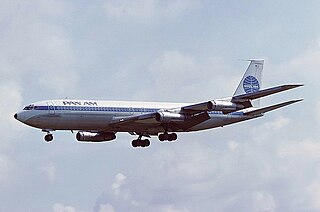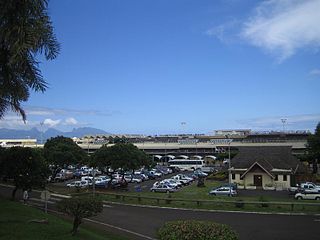
The Boeing 747 is a long-range wide-body airliner designed and manufactured by Boeing Commercial Airplanes in the United States between 1968 and 2023. After the introduction of the 707 in October 1958, Pan Am wanted a jet 2+1⁄2 times its size, to reduce its seat cost by 30%. In 1965, Joe Sutter left the 737 development program to design the 747. In April 1966, Pan Am ordered 25 Boeing 747-100 aircraft, and in late 1966, Pratt & Whitney agreed to develop the JT9D engine, a high-bypass turbofan. On September 30, 1968, the first 747 was rolled out of the custom-built Everett Plant, the world's largest building by volume. The 747's first flight took place on February 9, 1969, and the 747 was certified in December of that year. It entered service with Pan Am on January 22, 1970. The 747 was the first airplane called a "Jumbo Jet" as the first wide-body airliner.

The Boeing 707 is an early American long-range narrow-body airliner, the first jetliner developed and produced by Boeing Commercial Airplanes. Developed from the Boeing 367-80 prototype first flown in 1954, the initial 707-120 first flew on December 20, 1957. Pan Am began regular 707 service on October 26, 1958. With versions produced until 1979, the 707 was a swept wing quadjet with podded engines. Its larger fuselage cross-section allowed six-abreast economy seating, retained in the later 720, 727, 737, and 757 models.

The Boeing 777, commonly referred to as the Triple Seven, is an American long-range wide-body airliner developed and manufactured by Boeing Commercial Airplanes. The 777 is the world's largest twinjet and the most-built wide-body airliner. The jetliner was designed to bridge the gap between Boeing's other wide body airplanes, the twin-engined 767 and quad-engined 747, and to replace aging DC-10 and L-1011 trijets. Developed in consultation with eight major airlines, the 777 program was launched in October 1990, with an order from United Airlines. The prototype was rolled out in April 1994, and first flew in June. The 777 entered service with the launch operator United Airlines in June 1995. Longer-range variants were launched in 2000, and first delivered in 2004.
The Airline of the Islamic Republic of Iran, branded as Iran Air, is the flag carrier of Iran, which is headquartered at Mehrabad Airport in Tehran. As of 2023, it operates scheduled services to 72 destinations in Asia and Europe. Iran Air's main bases are Imam Khomeini International Airport and Mehrabad International Airport, both serving Tehran, the capital of Iran. Domestically, Iran Air is commonly known as Homa, which is the name of a mythical Persian phoenix or griffin, and also the acronym of Iran National Airlines in the Persian language. The airline's cargo division, Iran Air Cargo, operates scheduled services internationally using one cargo aircraft.

A jet airliner or jetliner is an airliner powered by jet engines. Airliners usually have two or four jet engines; three-engined designs were popular in the 1970s but are less common today. Airliners are commonly classified as either the large wide-body aircraft, medium narrow-body aircraft and smaller regional jet.
This is a list of aviation-related events from 1983.

Faa'a International Airport, also known as Tahiti International Airport, is the international airport of French Polynesia, located in the commune of Faaa, on the island of Tahiti. It is situated 5 km (3.1 mi) southwest of Papeete, the capital city of the overseas collectivity. It opened in 1960. Regional air carrier Air Tahiti and international air carrier Air Tahiti Nui are both based at the airport.

The Boeing 747-400 is a large, long-range wide-body airliner produced by Boeing Commercial Airplanes, an advanced variant of the initial Boeing 747. The "Advanced Series 300" was announced at the September 1984 Farnborough Airshow, targeting a 10% cost reduction with more efficient engines and 1,000 nautical miles [nmi] of additional range. Northwest Airlines became the first customer with an order for 10 aircraft on October 22, 1985. The first 747-400 was rolled out on January 26, 1988, and made its maiden flight on April 29, 1988. Type certification was received on January 9, 1989, and it entered service with NWA on February 9, 1989.

The Boeing 377 Stratocruiser was a large long-range airliner developed from the C-97 Stratofreighter military transport, itself a derivative of the B-29 Superfortress. The Stratocruiser's first flight was on July 8, 1947. Its design was advanced for its day; its relatively innovative features included two passenger decks and a pressurized cabin. It could carry up to 100 passengers on the main deck plus 14 in the lower deck lounge; typical seating was for 63 or 84 passengers or 28 berthed and five seated passengers.
This is a list of aviation-related events from 1977.

The Stratospheric Observatory For Infrared Astronomy (SOFIA) was a 80/20 joint project of NASA and the German Aerospace Center (DLR) to construct and maintain an airborne observatory. NASA awarded the contract for the development of the aircraft, operation of the observatory and management of the American part of the project to the Universities Space Research Association (USRA) in 1996. The DSI managed the German parts of the project which were primarily science-and telescope-related. SOFIA's telescope saw first light on May 26, 2010. SOFIA was the successor to the Kuiper Airborne Observatory. During 10-hour, overnight flights, it observed celestial magnetic fields, star-forming regions, comets, nebulae, and the Galactic Center.

Boeing Commercial Airplanes (BCA) is a division of the Boeing Company. It designs, assembles, markets, and sells commercial aircraft, including the 737, 767, 777, and 787, along with freighter and business jet variants of most. The division employs nearly 35,000 people, many working at the company's division headquarters in Renton, Washington or at more than a dozen engineering, manufacturing, and assembly facilities, notably the Everett Factory and Renton Factory, and the South Carolina Factory.

Combi aircraft in commercial aviation are aircraft that can be used to carry either passengers as an airliner, or cargo as a freighter, and may have a partition in the aircraft cabin to allow both uses at the same time in a mixed passenger/freight combination. The name combi comes from the word combination. The concept originated in railroading with the combine car, a passenger car that contains a separate compartment for mail or baggage.

Pan Am Flight 845 was a scheduled international passenger flight between Los Angeles and Tokyo, with an intermediate stop at San Francisco. The flight was operated by a Boeing 747 registered N747PA and named Clipper America.

Qantas 1 was a Qantas passenger flight between Sydney and London that was involved in a runway overrun accident at Don Mueang International Airport in Bangkok on 23 September 1999 as it was landing for a stopover.

Cheddi Jagan International Airport, formerly Timehri International Airport, is the primary international airport of Guyana. The airport is located on the right bank of the Demerara River in the city of Timehri, 41 kilometres (25 mi) south of Guyana's capital, Georgetown. It is the larger of the two international airports serving Georgetown with the other airport being the Eugene F. Correia International Airport.

As of July 2020, a total of 60 Boeing 747 aircraft, or just under 4% of the total number of 747s built, first flown commercially in 1970, have been involved in accidents and incidents resulting in a hull loss, meaning that the aircraft was either destroyed or damaged beyond economical repair. Of the 60 Boeing 747 aircraft losses, 32 resulted in no loss of life; in one, a hostage was murdered; and in one, a terrorist died. Some of the aircraft that were declared damaged beyond economical repair were older 747s that sustained relatively minor damage. Had these planes been newer, repairing them might have been economically viable, although with the 747's increasing obsolescence, this is becoming less common. Some 747s have been involved in accidents resulting in the highest death toll of any civil aviation accident, the highest death toll of any single airplane accident, and the highest death toll of a midair collision. As with most airliner accidents, the root of cause(s) in these incidents involved a confluence of multiple factors that rarely could be ascribed to flaws with the 747's design or its flying characteristics.
Qantas is Australia's largest airline. Qantas was founded in Winton, Queensland, on 16 November 1920 as Queensland and Northern Territory Aerial Services Limited by Paul McGinness, Sir Hudson Fysh and Sir Fergus McMaster, the latter of whom was chairman. Arthur Baird was employed as a chief aircraft engineer. McGinness left QANTAS for other interests, and Hudson Fysh remained with the company as General Manager & Managing Director. He retired as Sir Hudson Fysh KBE DFC, Chairman of QANTAS in 1966.
Over time, commercial airlines have established a number of scheduled ultra long-haul non-stop flights. These exceptionally long routes reduce the travel time between distant city pairs as well as the number of stops needed for passengers' travels, thereby increasing passenger convenience. For an airline, choosing to operate long flights can also build brand image as well as loyalty among a set of flyers. Therefore, competition among airlines to establish the longest flight occurs.
Qantas operates a fleet of Airbus A330, Airbus A380, Boeing 737 and Boeing 787 making a total of 125 aircraft. This list excludes subsidiaries Jetstar, QantasLink and Qantas Freight.



















